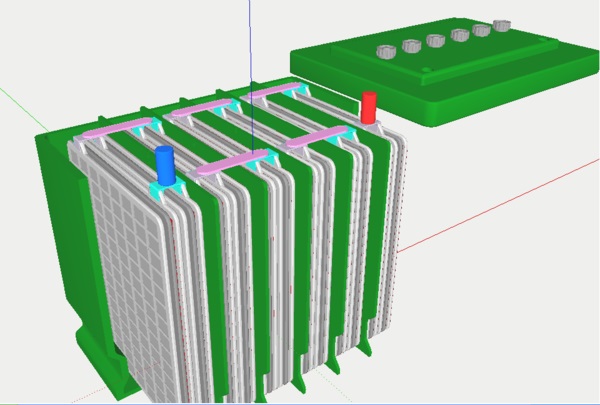Recognizing the signs of damage in lead-acid batteries, including OPzS batteries, is essential for timely maintenance and preventing further issues.
1. Decreased Capacity and Runtime
- Symptoms: The battery discharges more quickly than usual and cannot hold a charge for as long as it previously did.
- Causes: Sulfation, loss of active material, aging, or excessive deep discharges.
- Consequences: Reduced efficiency and frequent need for recharging.
2. Low or Uneven Voltage
- Symptoms: The battery voltage drops significantly during use, or individual cells show uneven voltage levels.
- Causes: Cell imbalance, internal short circuits, or deteriorating cell health.
- Consequences: Poor performance and the need for frequent equalization.
3. Swelling or Bulging
- Symptoms: Visible deformation of the battery casing, swelling, or bulging.
- Causes: Overcharging, internal gas buildup, or thermal runaway.
- Consequences: Risk of explosion, leakage, and complete battery failure.
4. Corrosion
- Symptoms: Visible corrosion on battery terminals, connectors, or the battery casing.
- Causes: Acid leakage, poor maintenance, or exposure to moisture.
- Consequences: Poor electrical connections, increased resistance, and potential safety hazards.
5. Excessive Gassing
- Symptoms: Noticeable hydrogen and oxygen gas production during charging, often accompanied by a strong sulfur smell.
- Causes: Overcharging, high charging voltage, or electrolyte imbalance.
- Consequences: Loss of electrolyte, increased risk of explosion, and acid spills.
6. Electrolyte Leakage
- Symptoms: Presence of liquid around the battery, corrosion on nearby surfaces, or lower than expected electrolyte levels.
- Causes: Cracks in the casing, overfilling, or overcharging leading to excessive gassing.
- Consequences: Corrosion, reduced electrolyte levels, and potential short circuits.
7. High Self-Discharge Rate
- Symptoms: The battery loses charge rapidly even when not in use.
- Causes: Internal short circuits, aging, or sulfation.
- Consequences: Frequent recharging and decreased battery life.
8. Slow or Incomplete Charging
- Symptoms: The battery takes longer than usual to charge or does not reach full charge.
- Causes: Sulfation, poor charger performance, or internal resistance increase.
- Consequences: Reduced capacity and efficiency.
9. Excessive Heat
- Symptoms: The battery becomes excessively hot during charging or discharging.
- Causes: Overcharging, internal short circuits, or high discharge rates.
- Consequences: Reduced battery life, thermal runaway, and potential safety hazards.
10. Unusual Noise
- Symptoms: Popping, bubbling, or hissing sounds during charging or discharging.
- Causes: Gassing, internal short circuits, or electrolyte boiling.
- Consequences: Increased risk of explosion or electrolyte leakage.
Preventive Measures and Maintenance
- Regular Monitoring: Regularly check voltage, specific gravity, and temperature of the battery cells.
- Proper Charging: Use a charger with the correct specifications for the battery type, and avoid overcharging and deep discharging.
- Maintenance: Keep terminals clean and tight, ensure electrolyte levels are adequate, and perform equalization charges as needed.
- Environment: Store and use batteries in a cool, well-ventilated area to prevent overheating and corrosion.
- Safety: Follow all manufacturer guidelines and safety protocols, including the use of personal protective equipment (PPE).
By recognizing these signs of damage and taking appropriate preventive measures, you can maintain the health and performance of lead-acid batteries effectively.


